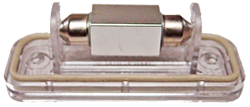All Model S produced around September 2015 and after include LED license plate lights. All other Tesla models (Model X, Model 3, and Model Y) include LED license plate lights. (Mar-2022 update)
The original Model S rear license plate lights use two 10-watt incandescent bulbs, not LEDs. They are positioned for all types of license plates (the USA, Europe’s wide plates, and others).
One of the simplest improvements is to swap out these bulbs for a couple of 1-watt LEDs. The LEDs should never need replacement, are brighter, have a cooler color, and save a tiny amount of power (about 18W). You can also see a bit better in the backup camera at night with the additional light.
It takes less than 20 minutes to switch them out. The bulbs are 36mm Festoon style, and a pair of replacement bulbs can be purchased on eBay or Amazon. Here’s one source on Amazon:
Do not buy a replacement bulb that has LEDs that are on multiple sides or stick out on the sides. Best are those that only have one or two LEDs per assembly that point in one direction.
There are two screws to remove from each of the 2 lights. Note carefully when you pull out the lens it’s orientation so you can later return them in the same orientation. When you remove the lens, the bulb should easily snap out of the socket and is held in place by the lens. Remove the old bulb from the lens and replace it with the new one. Orient the LEDs toward the lens.
Insert both bulbs back in the sockets, but wait to put the screws back. First, turn on the lights from the Controls screen, and confirm both are working. The LEDs are polarity sensitive, so if it’s backward, they will not light up (but are not harmed). If one or both does not light, remove the lens, pull out the bulb and turn the bulb 180 degrees and snap it back into the lens, and then put it back in the socket. It should work! Once they are both working, put the four screws back in. Do not over-tighten!
Our before and after pictures show the LEDs are slightly brighter and have a bit more coverage than the originals. For these photos, we used a white cardboard license placeholder.


13 comments
Why isn’t this standard on every new Model S? I like to believe that the engineers at Tesla Motors are aiming at best component choices for longevity and energy efficiency within their BOM budget. White LEDs are quite cheap nowadays.
Tesla actually has a fairly good reason for not using LEDs, but it was told to me in confidence. Nothing to do with cost. You can be sure the Model X will have LEDs.
Can you give us any clues as to what the reason was? I’ve had LED bulbs for over a year now with no side effects, but would be interested in knowing if there’s a good reason why they didn’t do it – thanks
There was a good reason, but I was told the reason in confidence by a Tesla engineer. I expect the Model X will have LED license plate lights.
These led lamps are not available what other ones work
I’ve added another source above and a note on what not to buy. You can also do a search for “Festoon 36mm 1W 12V LED” on Amazon, eBay or other sources. Be sure to look at how the LEDs are mounted as you don’t want ones that have LEDs on more than one side or expand beyond the normal Festoon bulb size.
I tried this modification. Purchased festoon LEDs with 16 SMD lights, but it didn’t fit. I have a 2014 Model S 85, so maybe the size of the well is different? Anyway, I’ve got regular sized LED festoons on the way – I expect them to fit.
Another issue: the incandescent festoon bulbs on my 2014 MS measure 38.5mm, so I purchased 39mm LED replacements. A bit tight, but better fitting than the 36mm LEDs. I also attached a 6 inch LED strip to the area just above the license plate. I ran the wire above the rear view camera under the plastic to the driver’s side license plate light. I just stripped the wires and placed them into the festoon socket. Now the license plate is much, much brighter! How do I upload photos?
Thanks
FYI – I ordered the led lights from the above link and they would not power on.
DSMITH – where can I find the ones you are talking about?
This will occur if the LEDs are installed backwards. Remove the LED and switch it 180 degrees and it will very likely work. In the unusual case where it still fails, then it sounds like the LED is defective, and you should contact the seller for a replacement.
So much brighter.
Note: thre are two types of LED Bubs. with a resistor and without.
If you use the ones with a resistor they will consume the same amount of energy as the incandessant bulb. The resistor will give off heat and requires the bulb have a heat sink.
I used the ones without a resistor and they work great.
I just did this very easy mod. Looks much better now and matched the rest of the exterior LEDs.